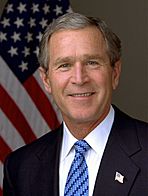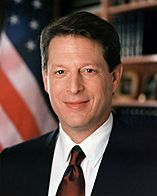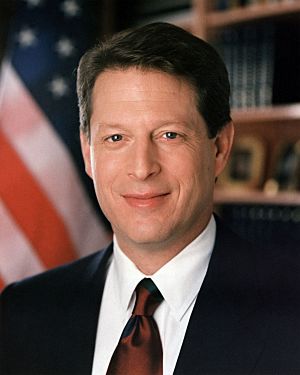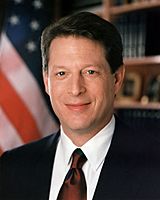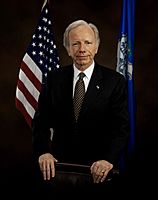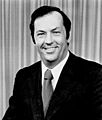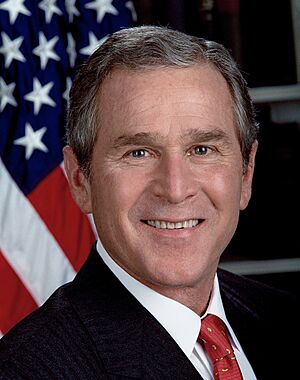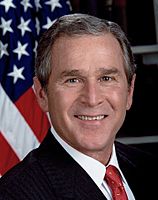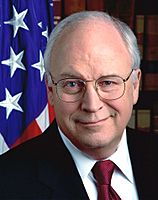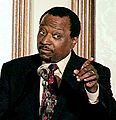United States presidential election, 2000 facts for kids
|
|||||||||||||||||||||||||||||
|
|||||||||||||||||||||||||||||
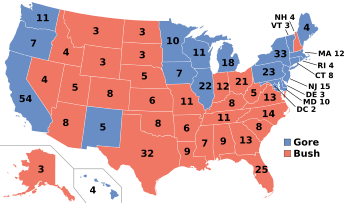
Presidential election results map. Red denotes states won by Bush/Cheney(30), Blue denotes those won by Gore/Lieberman(20+DC).
|
|||||||||||||||||||||||||||||
|
|||||||||||||||||||||||||||||
The United States presidential election of 2000 was a very close race. It was held on November 7, 2000. The main candidates were Al Gore from the Democratic Party and George W. Bush from the Republican Party. Al Gore was the Vice President at the time. George W. Bush was the governor of Texas. His father, George H. W. Bush, had also been president.
The current president, Bill Clinton, could not run again. This is because presidents can only serve two terms. Vice President Gore won the Democratic Party's support to be their candidate. George W. Bush was expected to win the Republican nomination. He faced some tough competition but secured his party's nomination. Many other candidates also ran, including Ralph Nader.
Bush chose Dick Cheney as his running mate (Vice President candidate). Gore chose Senator Joe Lieberman. Both candidates mostly talked about issues important to people in the U.S. These included the national budget, tax cuts, and changes to social programs. They also discussed foreign policy. President Clinton and Vice President Gore did not campaign together very often. This was a planned choice.
Bush won the election by a very small margin. He received 271 electoral votes, while Gore received 266. There was a big disagreement about who won the state of Florida. Florida had 25 electoral votes, which were very important. This led to a recount of votes in Florida. It was also unusual because the winner, Bush, received fewer total votes from people across the country than Gore. The Supreme Court made a decision on December 12, 2000, in a case called Bush v. Gore. This decision stopped the recounts. It effectively gave Florida's votes to Bush, making him the winner.
Contents
Who Ran for President?
Democratic Party Candidates
Al Gore and Joe Lieberman
The Democratic Party chose Al Gore as their candidate for President. He was the Vice President under Bill Clinton. Gore chose Senator Joe Lieberman from Connecticut as his running mate. Lieberman would have been Vice President if Gore had won.
| Democratic Party Ticket, 2000 | |||||||||||||||||||||||||||||
| Al Gore | Joe Lieberman | ||||||||||||||||||||||||||||
|---|---|---|---|---|---|---|---|---|---|---|---|---|---|---|---|---|---|---|---|---|---|---|---|---|---|---|---|---|---|
| for President | for Vice President | ||||||||||||||||||||||||||||
| 45th Vice President of the United States (1993–2001) |
U.S. Senator from Connecticut (1989–2013) |
||||||||||||||||||||||||||||
| Campaign | |||||||||||||||||||||||||||||
Other Democratic Candidates
- Bill Bradley, a former U.S. Senator from New Jersey, also ran for the Democratic nomination. He later stopped his campaign in March 2000 and supported Al Gore.
-
Former Senator Bill Bradley of New Jersey
Republican Party Candidates
George W. Bush and Dick Cheney
The Republican Party chose George W. Bush as their candidate for President. He was the governor of Texas. Bush chose Dick Cheney as his running mate. Cheney had served as the U.S. Secretary of Defense before.
| Republican Party Ticket, 2000 | |||||||||||||||||||||||||||||
| George W. Bush | Dick Cheney | ||||||||||||||||||||||||||||
|---|---|---|---|---|---|---|---|---|---|---|---|---|---|---|---|---|---|---|---|---|---|---|---|---|---|---|---|---|---|
| for President | for Vice President | ||||||||||||||||||||||||||||
| 46th Governor of Texas (1995–2000) |
17th U.S. Secretary of Defense (1989–1993) |
||||||||||||||||||||||||||||
| Campaign | |||||||||||||||||||||||||||||
Other Republican Candidates
Many other people ran for the Republican nomination. These included:
- Senator John McCain from Arizona
- Former U.S. Ambassador Alan Keyes from Maryland
- Businessman Steve Forbes from New Jersey
- Senator Orrin Hatch from Utah
- Former Secretary of Labor Elizabeth Dole from North Carolina
- Publisher and author Pat Buchanan from Virginia
- Former Vice President Dan Quayle from Indiana
- Former Governor Lamar Alexander from Tennessee
- Senator Robert C. Smith from New Hampshire
- Representative John Kasich from Ohio
- Businessman Herman Cain from Nebraska
-
Senator John McCain of Arizona
-
Former U.S. ECOSOC Ambassador Alan Keyes of Maryland
-
Businessman Steve Forbes of New Jersey
-
Former Secretary of Labor Elizabeth Dole of North Carolina
-
Publisher and author Pat Buchanan of Virginia
-
Former Vice President Dan Quayle of Indiana
-
Former Governor Lamar Alexander of Tennessee
-
Senator Robert C. Smith of New Hampshire
-
Businessman Herman Cain of Nebraska
The Florida Recount and Supreme Court Decision
The election results were very close. The winner of the election was not clear for several weeks. This was mainly because of the votes in Florida. The difference in votes between Bush and Gore in Florida was tiny. This led to a mandatory machine recount. After that, Gore's campaign asked for hand recounts in several counties.
The "Butterfly Ballot"
One issue in Florida was the design of the ballot in Palm Beach County. Some voters said it was confusing. They called it a "butterfly ballot." They believed it might have caused them to accidentally vote for a different candidate than they intended.
Legal Battles and the Supreme Court
The recount process in Florida led to many legal challenges. Both campaigns went to court. The Florida Supreme Court allowed the recounts to continue. However, the U.S. Supreme Court eventually stepped in. On December 12, 2000, the U.S. Supreme Court made a decision in the case of Bush v. Gore. This decision stopped the recounts. It effectively meant that George W. Bush won Florida's electoral votes. This made him the winner of the presidential election.
Popular Vote vs. Electoral College
George W. Bush won the election with 271 electoral votes. However, Al Gore received more individual votes from people across the country. Gore had about 500,000 more popular votes than Bush. This was only the fourth time in U.S. history that the winner of the presidency did not win the popular vote. This situation highlighted the importance of the Electoral College system in U.S. presidential elections.
Images for kids
-
Bill Clinton, the incumbent president in 2000.
See also
 In Spanish: Elecciones presidenciales de Estados Unidos de 2000 para niños
In Spanish: Elecciones presidenciales de Estados Unidos de 2000 para niños


